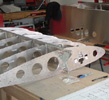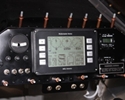


random user submitted photo
Tightening AeroVee baffles
6 posts
• Page 1 of 1
Tightening AeroVee baffles
Does anyone have any tips or photos of how you're tightening up your AV baffles? Since all but the rear baffle regularly come off for maintenance, it doesn't make sense to just RTV everything, so wondering if there are other tricks or tips for tightening things up. My 1, 2 and 4 CHTs are all doing well if I keep the RPMs at 2,700 or below, but the #3 (right rear) keeps itself from 395 to 405, with some occasional spikes to 410. Would love to fix that, and be able to run higher RPMs for longer periods of time.
19 total hours on the engine.
Thanks,
Mike Smith
Sonex N439M
19 total hours on the engine.
Thanks,
Mike Smith
Sonex N439M
Mike Smith
Sonex N439M
Scratch built, AeroVee, Dual stick, Tail dragger
http://www.mykitlog.com/mikesmith
Sonex N439M
Scratch built, AeroVee, Dual stick, Tail dragger
http://www.mykitlog.com/mikesmith
- mike.smith
- Posts: 1430
- Joined: Tue Jan 29, 2013 8:45 pm
Re: Tightening AeroVee baffles
Hi Mike,
I just use the self-tapping screws specd by Sonex. None have come loose.
Generally, you won't see things start to loosen up until 25 hrs or so. Then you'll see temps drop. In the meantime, do the mag test. Get established straight and level; make note of your rpms and temps. Then shut off only the secondary ignition. That's the electronic ignition, not the magnetron.
If your rpms increase by 200 or so, and temps drop 30-40 deg, your secondary is too far advanced. Gotta do this in the air under flight load. On the ground they may match 100% and fool you into thinking you're good. If you see a diff, you only need to rotate the trigger magnet about 1/16" clockwise looking at back of engine.
I just use the self-tapping screws specd by Sonex. None have come loose.
Generally, you won't see things start to loosen up until 25 hrs or so. Then you'll see temps drop. In the meantime, do the mag test. Get established straight and level; make note of your rpms and temps. Then shut off only the secondary ignition. That's the electronic ignition, not the magnetron.
If your rpms increase by 200 or so, and temps drop 30-40 deg, your secondary is too far advanced. Gotta do this in the air under flight load. On the ground they may match 100% and fool you into thinking you're good. If you see a diff, you only need to rotate the trigger magnet about 1/16" clockwise looking at back of engine.
- corton
- Posts: 43
- Joined: Fri May 03, 2013 11:00 am
Re: Tightening AeroVee baffles
corton wrote:Hi Mike,
I just use the self-tapping screws specd by Sonex. None have come loose.
Generally, you won't see things start to loosen up until 25 hrs or so. Then you'll see temps drop. In the meantime, do the mag test. Get established straight and level; make note of your rpms and temps. Then shut off only the secondary ignition. That's the electronic ignition, not the magnetron.
If your rpms increase by 200 or so, and temps drop 30-40 deg, your secondary is too far advanced. Gotta do this in the air under flight load. On the ground they may match 100% and fool you into thinking you're good. If you see a diff, you only need to rotate the trigger magnet about 1/16" clockwise looking at back of engine.
The screws are all there, per plans. But I know people add RTV and do all sorts of things to close gaps and "tighten up" the baffles to prevent air leakage. That's what I'm wondering about.
As for the in-air test, I've done that. I get no change in RPM or temps when I turn off the secondary. The engine runs the same with the secondary on or off, so I think the timing is fine.
Thanks for the input. I'll take anything :-)
Mike
Mike Smith
Sonex N439M
Scratch built, AeroVee, Dual stick, Tail dragger
http://www.mykitlog.com/mikesmith
Sonex N439M
Scratch built, AeroVee, Dual stick, Tail dragger
http://www.mykitlog.com/mikesmith
- mike.smith
- Posts: 1430
- Joined: Tue Jan 29, 2013 8:45 pm
Re: Tightening AeroVee baffles
mike.smith wrote:My 1, 2 and 4 CHTs are all doing well if I keep the RPMs at 2,700 or below, but the #3 (right rear) keeps itself from 395 to 405, with some occasional spikes to 410. Would love to fix that, and be able to run higher RPMs for longer periods of time.
19 total hours on the engine.
Thanks,
Mike Smith
Sonex N439M
Hi Mike,
Carl is correct in that the temps will come down as you get some time on the engine.
A few more thoughts. My Aerovee had a rear cylinder that was a bit hotter than the other. Working with some deflectors in the front I managed to get the temps to be almost even but still on a really hot day they would read 385ºF. Since I was reading under the plugs I thought that was acceptable. Also I would advise that you don't "baby" the engine. As long as the temps are not over what you are seeing I would let it spin. Higher airspeed will give better cooling. I trust you have the pants and fairings installed.
It has been mentioned that using some filler to smooth the transition of the lip at the top of the cowling openings makes a noticeable difference in cooling on the Aerovee. Also, if you have a bottom mounted oil cooler and your oil temps are a bit low you can close the opening a little and this helps reduce the air pressure in the lower cowl and will aid in cooling.
Back to Carl's point ... seems I had nearly 40 hours on mine before the temps settled down to a level where I wasn't constantly staring at the readings.
Dunno if this helps ...
Dale
N319WF
-

daleandee - Posts: 877
- Joined: Fri Feb 01, 2013 6:14 pm
Re: Tightening AeroVee baffles
All good points, thanks. I was planning to look at the inlets some more. I thought about a deflector, but feared the forward cylinder might suffer. Can't hurt to try. It's called "experimental" after all. It's hard not to worry about the numbers. 450 deg is where, as I understand it, the metallurgy of the aluminum heads begins to break down. So when I see 410 I begin to worry.
Again, thanks for the input.
Mike
Again, thanks for the input.
Mike
Mike Smith
Sonex N439M
Scratch built, AeroVee, Dual stick, Tail dragger
http://www.mykitlog.com/mikesmith
Sonex N439M
Scratch built, AeroVee, Dual stick, Tail dragger
http://www.mykitlog.com/mikesmith
- mike.smith
- Posts: 1430
- Joined: Tue Jan 29, 2013 8:45 pm
Re: Tightening AeroVee baffles
I chased the temps when I first started flying and nearly drove myself crazy. Keep flying and quit worrying until I would say 50 hours. Do what is needed to keep the heads under say 425 until you get close to 40 hours or so. The big thing to do is air check the ignition for differences with primary only and secondary on. Getting the ignitions dialed in will make the biggest difference and is something to play with while breaking in the engine. Mine started running cooler and had more power after the 50 hour mark. After 50 hours or so and after you get the temps to stay the same with both ignitions running as opposed to just the primary' then you can start playing with the cooling inlets and their transition inside the cowl, or reducing the oil cooler inlet. At 20 hours +/- I would avoid major surgery and just go fly! Sure. keep an eye on everything but if it's all below critical temp wise just fly it and let it settle in.
for what its worth!
for what its worth!
Bill Larson
N861SX
Sonex, polished, tail wheel, Generation 4 Jabiru 3300
N861SX
Sonex, polished, tail wheel, Generation 4 Jabiru 3300
- wlarson861
- Posts: 499
- Joined: Wed Dec 05, 2012 11:41 pm
6 posts
• Page 1 of 1
Who is online
Users browsing this forum: No registered users and 21 guests







